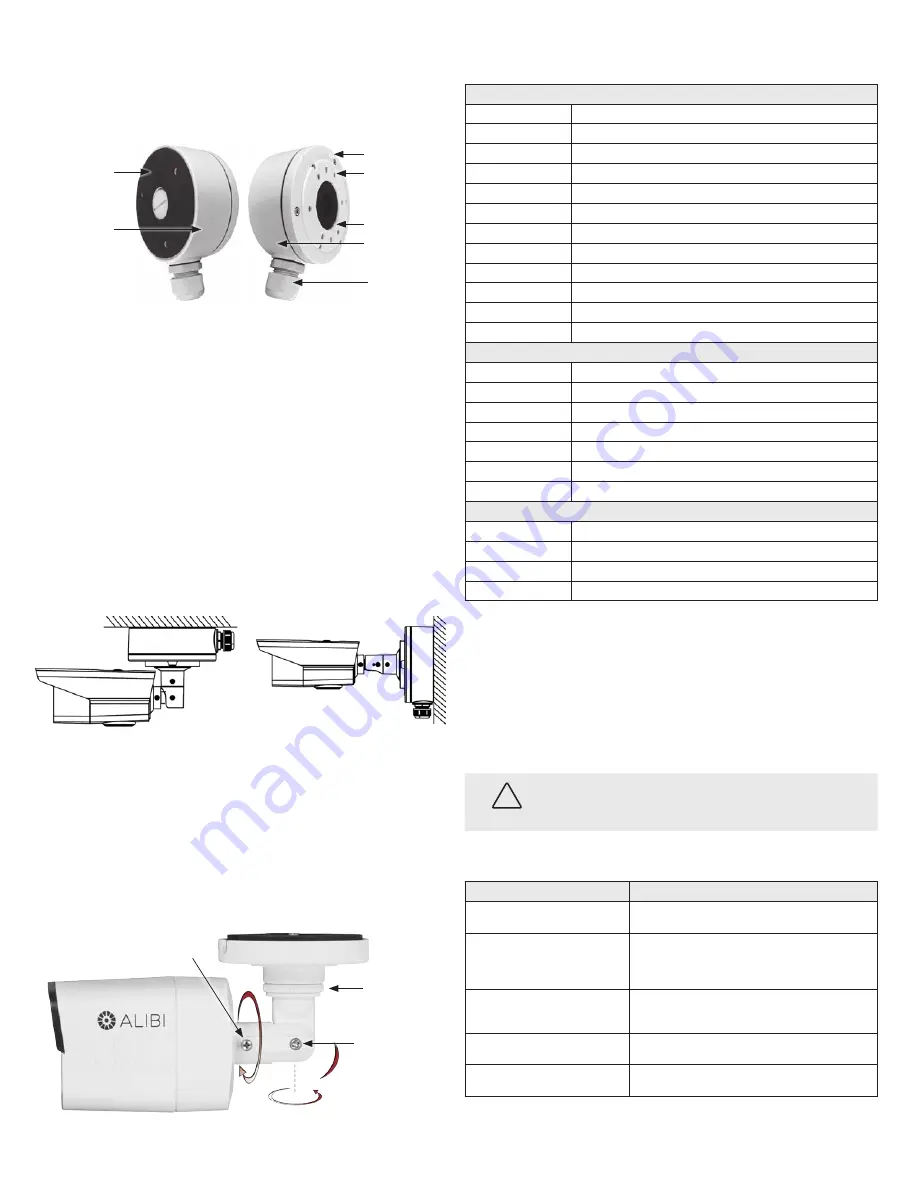
2
www.observint.com
•
Mounting the camera with a junction box
The
ALI-AJ6
junction box is shown below. It can be attached to a wall or ceiling. Video and power
extension cables can be routed in through the opening in the back of the box or through the conduit
coupling, and attached to the camera drop cables inside the enclosure.
Front
Front plate
Back Box
Back Box
Conduit
coupling / cable
channel
Back
“UP”label
Holes for
mounting
screws (3)
Holes for
mounting
base screws (6)
To use the junction box:
1.
Remove the ALI-AJ6 front plate from the box by removing the three screws (see above).
2.
Attach the front plate to the camera mounting base using three screws. If the box will be wall
attached to a wall, ensure that the “
UP
” label on the mounting plate is at the top of the camera, and
the cable channel in the camera mounting base is toward the bottom of the camera.
3.
Using the ALI-AJ6 box as a guide, mark and then drill three holes for the screws that will attach the
box to the wall or ceiling. If the extension cables will be routed into the box through the mounting
surface, also drill a hole for the extension cables.
4.
Attach the box to a wall or ceiling with three screws. Ensure that the wall or ceiling will support at
least three times the weight of the camera with the junction box.
5.
Route the video and power extension cables into the box.
6.
Attach the video and power extension cable to the camera drop cables. Observe the polarity of the
power cable connector as shown on page 1 of this guide.
7.
Reattach the ALI-AJ6 front plate (with the camera) to the box.
Step 2. Camera adjustments
1.
Apply power to the camera.
2.
Verify that video from the camera can be seen on the HD-TVI DVR monitor.
3.
While observing video from the camera, loosen the mounting bracket pan, tilt and rotation
adjustment lock screws, point the camera at your surveillance target, and then tighten adjustment
lock screws and lock nut to hold the camera in position.
The mounting bracket pan adjustment can be made after loosening the lock nut (see the photo
below). Use a Phillips #1 screwdriver for the elevation and rotation adjustment lock screws.
0° ~ 360°
0° ~ 90°
Loosen for rotation
adjustment: 0° ~ 360°
Loosen lock
nut for pan
adjustment
Loosen for
tilt
adjustment
Camera mounting bracket adjustment
Specifications
Camera
Image Sensor
2MP CMOS Image Sensor
Effective Pixels
1920(H)*1080(V)
Min. Illumination
0.01 Lux @ (F1.2, AGC ON), 0 Lux with IR
Shutter Time
1/30 s to 1/50,000 s
Lens
2.8 mm, 103° field of view
Lens Mount
M12
Adjustment Range
Pan: 0 - 360°, Tilt: 0 - 180°, Rotation: 0 - 360°
Video Frame Rate
1080p @ 30 fps
Video Output
1 Analog HD output
Synchronization
Internal Synchronization
S/N Ratio
> 62 dB
Signal System
NTSC
General
Operating Conditions
-40 °F ~ 140 °F (-40 °C ~ 60 °C ) Humidity 90% or less (non-condensing)
Power Supply
12 Vdc ± 15%
Power Consumption
Max. 4 W
Weather Proof
IP66
IR Range
Up to 65 ft (20 m)
Dimension
Φ2.76” × 5.89” (Φ70 mm × 149.5 mm)
Weight
0.88 lb (400 g)
Additional info
Camera type
Bullet
Type of camera lens
Fixed
Type of IR sensor
Standard
Wide Dynamic Range
No
Step 3.
Cleaning
Clean the camera dome with an approved glass cleaning solution and a lint free cloth.
•
Dust can be removed from the unit by wiping it with a soft damp cloth. To remove stains, gently rub
the surface with a soft cloth moistened with a mild detergent solution, then rinse and dry it with a
soft cloth.
•
Remove all foreign particles, such as plastic or rubber materials, attached to the camera housing.
These may cause damage to the surface over time.
CAUTION
Do not use benzene, thinner or other chemical products on the camera assembly; these may
dissolve the paint and promote damage of the surfaces. Before using any chemical product,
carefully follow the accompanying instructions.
Troubleshooting
Problem
Possible Cause
Nothing appears on the screen
- Check the power connection.
- Check the video signal cable connection to the monitor.
The video image is dim or not clear.
- If the camera lens is dirty, clean it with a soft, clean cloth.
- Adjust the monitor controls, if necessary.
- If the camera is facing a very strong light, change the camera position.
- Adjust the lens focus.
The screen is dark.
- Adjust the contrast control of the monitor.
- If you have an intermediate device, set the impedance (75 Ω /Hi-Z)
properly, and check the cable connections.
The camera is not working properly and the
surface of the camera is hot.
- Verify that the camera is correctly connected to an appropriate regulated
power source.
The image on the monitor flickers
- Make sure that the camera isn’t facing direct sunlight or fluorescent light.
If necessary,change the camera position.
© 2015 Observint Technologies. All rights reserved.


